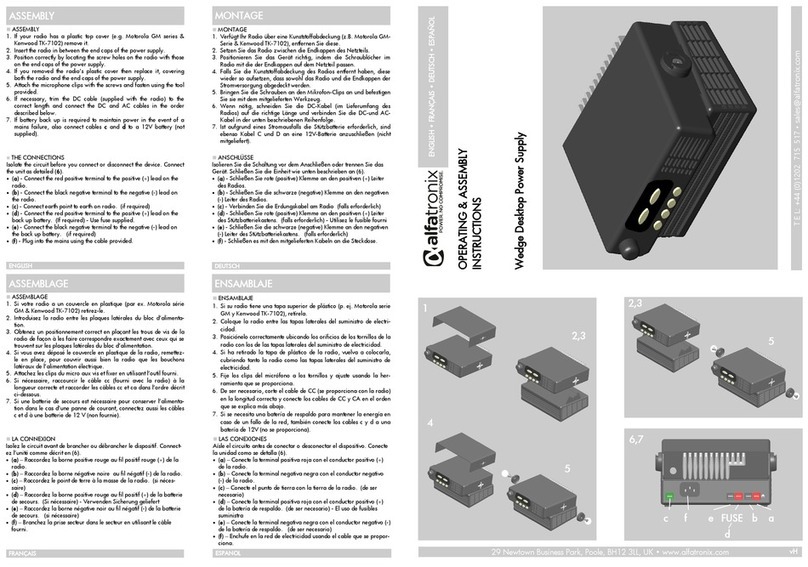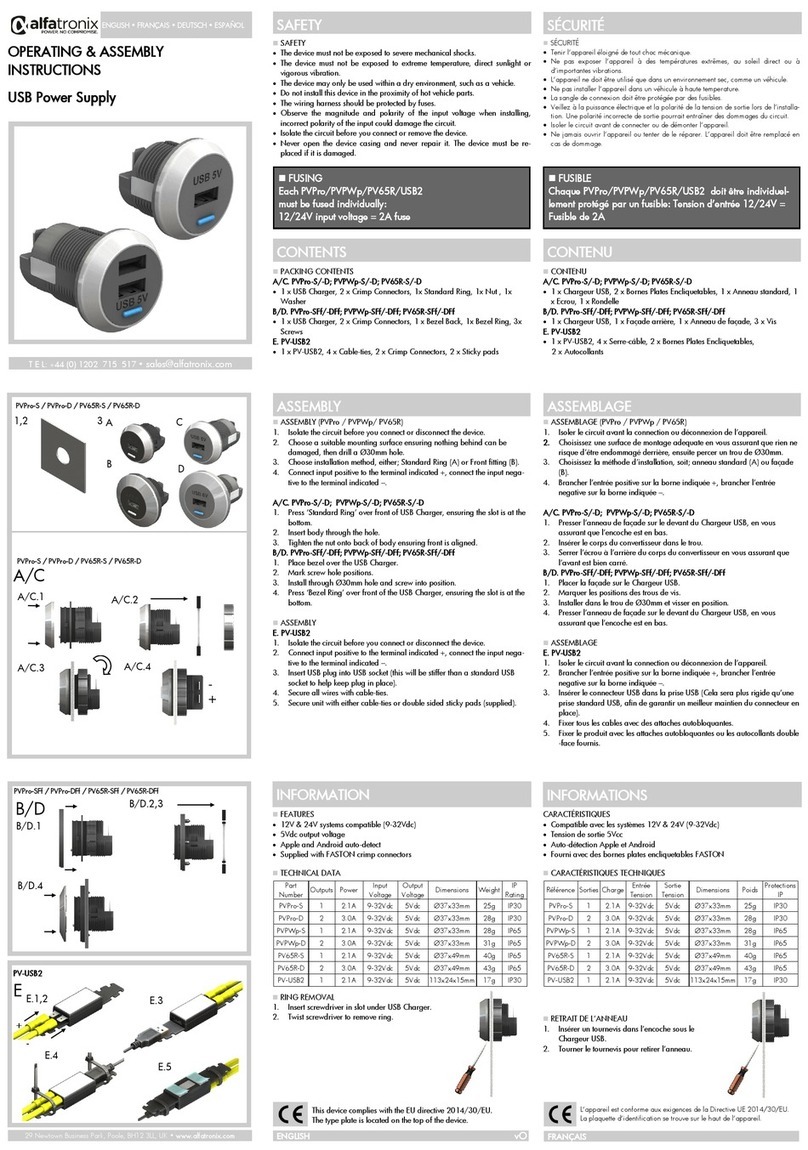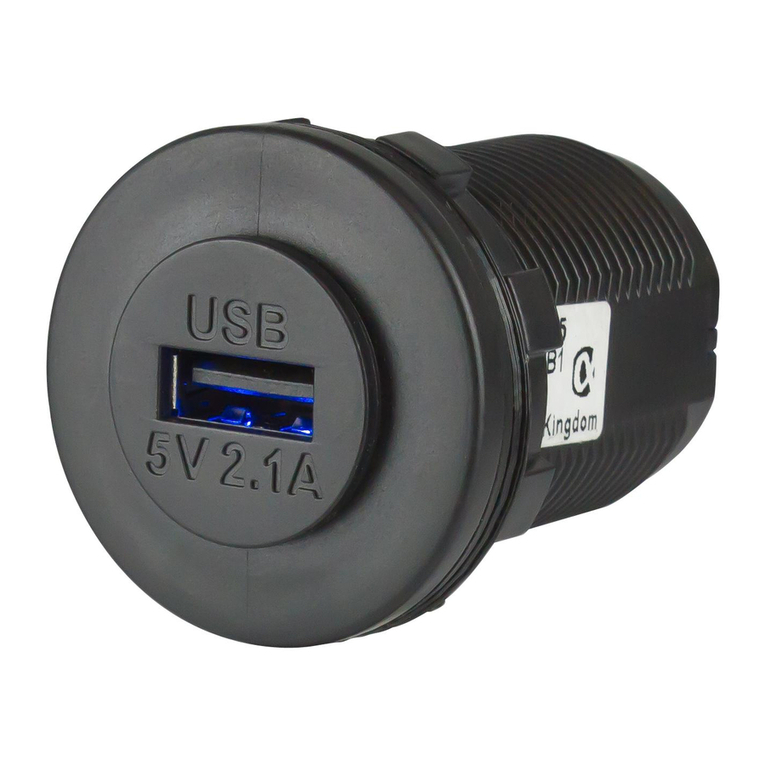
ASSEMBLY
PROGRAMMING
OPERATING & ASSEMBLY
INSTRUCTIONS
PowerTector PT40 & PT60
PACKING CONTENTS
1 x PowerTector 3 x Screws
5 x Crimp Connectors 1 x Programming Lead
FEATURES
12V / 24V Automatic mode selection (12V mode 8<V≤17 , 24V mode
17<V≤35)
10 Programmable voltage settings
Supplied with FASTON crimp connectors for low current connections
IP65 rated
Switch connection for remote on/off
Connection for remote alarm
OPERATION
The PowerTector will guard against excessive battery discharge by disconnecting the
load before the battery voltage drops too low. Ten seconds after the battery voltage
drops below the disconnect threshold the alarm output will activate. If the battery
voltage is still below the disconnect threshold after a total of 60s the PowerTector will
disconnect the load from the battery and deactivate the alarm.
The load will remain disconnected until the battery voltage rises above the reconnect
threshold.
The PowerTector will protect the load by disconnecting it if the battery voltage
exceeds 19V on a 12V system or 32V on a 24V system.
ASSEMBLY
1. Select a cool and ventilated position to install the device which is not exposed to
direct sunlight.
2. Mount as close to the battery as possible using a wire of sufficient diameter.
3. Isolate the power to the wiring before commencing installation.
4. Mount using the three mounting holes with screws or bolts.
5. Connect the ‘ground’ terminal.
6. Connect the ‘input positive’ terminal.
7. If required program the unit as described below.
8. Connect the ‘output positive’ once no further programming is required.
9. Connect the alarm and switch if required.
THE CONNECTIONS
Isolate the circuit before you connect or disconnect the device. Connect the unit as
detailed in the wiring diagram.
PROGRAMMING
There are 4 settings that can be defined by the user, each setting is in a Program
Family, as shown in the table below. Changing the setting within a Program Family
does not affect any other Program Family.
Program Family 1: Operating voltage range. P1-P10 (P7 is default).
Program Family 2: Alarm output mode.. P11 (default)—The alarm output will be
constantly active 10s after the voltage drops below the disconnect threshold. It will
deactivate if the voltage rises above the disconnect threshold or 60s after the voltage
drops below the disconnect threshold.
The alarm will activate in pulse mode if the battery voltage rises above 19V for a
12V system or 32V for a 24V system.
P12—The alarm output will be constantly active 10s after the voltage drops below the
disconnect threshold. It will deactivate if the voltage rises above the reconnect
threshold.
The alarm output will not activate if the voltage rises above the over-voltage protec-
tion level.
This mode can be used for enabling an external battery charger to replenish the
battery that the PowerTector is protecting.
Program Family 3: Switch terminal mode. P13 (default)—The PowerTector output is
disconnected when the switch terminal is connected to the negative terminal of the
battery.
P14—The PowerTector output is disconnected when the switch terminal is connected
to the positive terminal of the battery.
Program Family 4: Voltage range select. P15 (default)—The unit will automatically
select the voltage range (12V or 24V) each time power is applied.
P16—The unit will operate as a 12V unit only.
P17—The unit will operate as a 24V unit only.
To change a program:
1. Temporally connect together the ‘input positive’ and the ‘program’ terminal using
the programming lead supplied.
2. The LED will start to flash, each flash indicates the program to be selected.
3. Keep the connection until the LED has flashed the number of times for the desired
program then remove the connection.
4. The LED will then flash the number of times to confirm the selected program.
Alarm** - The use of a relay requires a free wheeling diode to prevent damage - see
application note AN-PT01.
29 Newtown Business Park, Poole, BH12 3LL, UK • www.alfatronix.com
This device complies with the EU directive 2004/108/EC.
The type plate is located on the top of the device.
SAFETY
SAFETY
This PowerTector is for ancillary equipment only. It must not be used to
disconnect equipment that is critical to the safe operation of the vehicle.
The device must not be exposed to severe mechanical shocks.
The device must not be exposed to extreme temperature, direct sunlight or
vigorous vibration.
The device may only be used within a dry environment, such as a vehicle.
Do not install this device on hot vehicle parts and ensure there is sufficient
space around the device for air circulation and cooling.
The wiring harness should be protected by fuses.
Observe the magnitude and polarity of the input/output voltage when
installing, incorrect polarity of the output could damage the circuit.
Isolate the circuit before you connect or remove the device.
Ensure that the output of the device is not short-circuited.
Never open the device casing and never repair it. The device must be
replaced if it is damaged.
ENGLISH
FUSING
The input and ground wiring must be fused appropriately.
For the ground, minimum 500mA to 1A maximum.
Part Number /
Référence
Current /
Courant
Rated Voltage/
Tension nominale
Dimensions/
Dimensions
Weight/
Poids
PT40 40A 12V/24V 76x78x33mm 155g
PT60 60A 12V/24V 76x78x33mm 155g
TECHNICAL DATA / CARACTÉRISTIQUES TECHNIQUES
PROGRAM MODES / MODES DE PROGRAMMATION
* Factory default settings / Réglages par défaut
(1) - Input Positive (1) - Entrée positive
(2) - Output Positive (2) - Sortie positive
(3) - Program (3) - Programme
(4) - Alarm** (4) - Alarme**
(5) - Ground (5) - Terre
(6) - Switch (6) - Commutateur
(F)- Fuses (F)- Fusibles
ASSEMBLAGE
PROGRAMMATION
CONTENU
1 x PowerTector 3 x Vis
5 x Bornes Plates Encliquetables 1 x Fil de programmation
CARACTERISTIQUES
Sélection automatique du mode 12 V / 24 V (mode 12 V, 8<V≤17, mode 24 V,
17<V≤35)
10 réglages de tension programmables
Fourni avec des bornes plates encliquetables FASTON
Indice de protection IP65
Connexion pour commutateur marche / arrêt à distance
Connexion pour alarme à distance
FONCTIONNEMENT
Le PowerTector protège contre toute décharge excessive de la batterie en décon-
nectant la charge avant que la tension de la batterie n’atteigne un niveau trop faible.
Dix seconde après que la tension de la batterie chute en-deçà du seuil de déconnex-
ion, la sortie de l’alarme s’active. Si la tension de la batterie reste inférieure au seuil
de déconnexion après une période totale de 60 s,le PowerTector déconnecte la
charge de la batterie et désactive l’alarme.
La charge reste déconnectée jusqu’à ce que la tension de la batterie dépasse le seuil
de reconnexion.
Le PowerTector protège la charge en la déconnectant lorsque la tension de la batterie
excède 19 V sur un système 12 V ou 32 V sur un système 24 V.
ASSEMBLAGE
1. Sélectionner un endroit frais et aéré pour installer le dispositif. Ne pas exposer à
la lumière directe du soleil.
2. Monter aussi près que possible de la batterie en utilisant un fil de diamètre
suffisant.
3. Isoler l’alimentation du câblage avant de démarrer l’installation.
4. Monter via les trois orifices de fixation en utilisant des vis ou des boulons.
5. Connecter le terminal « terre »
6. Connecter le terminal « entrée positive ».
7. Si nécessaire, programmer l’unité en suivant les consignes ci-dessous.
8. Connecter la « sortie positive » une fois la programmation achevée.
9. Connecter l’alarme et le commutateur, si nécessaire.
LA CONNEXION
Isoler le circuit avant de connecter ou de déconnecter le dispositif. Raccorder l’unité
conformément au schéma de câblage.
PROGRAMMATION
Il y a quatre paramètres qui peuvent être définis par l’utilisateur, chaque paramètre
fait partie d’une famille de programmes, comme indiqué dans la table ci-dessous. Le
changement d’un paramètre à l’intérieur d’une famille de programmes n’affecte pas
les autres familles de programmes.
Famille de programmes 1: Gamme de tension de fonctionnement. P1-P10 (P7 est le
programme par défaut).
Famille de programmes 2: le mode de sortie Alarme. (P11 est le programme par
défaut). La sortie alarme sera active en continu, 10 secondes après que la tension
soit tombée en dessous du seuil de déconnexion. Elle sera desactivée si la tension
passe au-dessus du seuil de déconnexion ou 60 secondes après que la tension soit
tombée en dessous du seuil de déconnexion.
L’alarme sera activée en mode impulsion si la tension de la batterie passe au dessus
de 19V pour un système 12V ou 32V pour un système 24V.
P12 –La sortie alarme sera active en continu, 10 secondes après que la tension soit
tombée en dessous du seuil de déconnexion. Elle sera desactivée si la tension passe
au-dessus du seuil de reconnexion.
La sortie alarme ne sera pas activée si la tension passe au-dessus du niveau de
protection de surtension.
Ce mode peut être utilisé pour activer un chargeur de batterie externe pour remplir
de nouveau la batterie que le PowerTector protège.
Famille de programmes 3: Commuter mode terminal P13 (default)—La sortie du
PowerTector se déconnecte lorsque le terminal du commutateur est connecté au
terminal négatif de la batterie.
P14—La sortie du PowerTector se déconnecte lorsque le terminal du commutateur est
connecté au terminal positif de la batterie.
Famille de programmes 4: Sélection de la gamme de tension. P15 (programme par
défaut) –l’unité sélectionnera automatiquement la gamme de tension (12V ou 24V)
chaque fois que la tension sera appliquée.
P16 –L’unité fonctionnera comme une unité 12V uniquement.
P17 - L’unité fonctionnera comme une unité 24V uniquement.
Pour modifier un programme :
1. Connecter de manière provisoire le terminal « entrée positive » et le terminal de
« programmation » en utilisant le fil de programmation fourni.
2. La LED commence à clignoter, chaque clignotement indiquant le programme à
sélectionner.
3. Maintenir la connexion jusqu’à ce que le nombre de clignotements de la LED
corresponde à celui du programme souhaité, puis retirer la connexion.
4. La LED clignote un même nombre de fois pour confirmer la sélection du pro-
gramme.
Alarme** - L'utilisation d'un relais nécessite une diode de roue libre pour empêcher
tout dommage - cf. Note d'application AN-PT01.
L’appareil est conforme aux exigences de la Directive UE 2004/108/
CE. La plaquette d’identification se trouve sur le haut de l’appareil.
SÉCURITÉ
SECURITE
Ce PowerTector est exclusivement pour des équipements accessoires. Il ne doit
absolument pas être utilisé pour déconnecter un équipement essentiel à la sécurité
du fonctionnement du véhicule.
Tenir l’appareil éloigné de tout choc mécanique.
Ne pas exposer l’appareil à des températures extrêmes, au soleil direct ou à
d’importantes vibrations.
L’appareil ne doit être utilisé que dans un environnement sec, comme un véhicule.
Ne pas installer l’appareil dans un véhicule à haute température et prenez garde
que l’espace entourant l’appareil soit assez large pour qu’il puisse être ventilé et
se refroidir.
La sangle de connexion doit être protégée par des fusibles.
Veillez à la puissance électrique et la polarité de la tension de sortie lors de
l’installation. Une polarité incorrecte de sortie pourrait entraîner des dommages
du circuit.
Isoler le circuit avant de connecter ou de démonter l’appareil.
Assurez-vous que la sortie de l’appareil n’est pas court-circuitée.
Ne jamais ouvrir l’appareil ou tenter de le réparer. L’appareil doit être remplacé
en cas de dommage.
FRANÇAIS
FUSIBLE
Le fusible d’entrée et de sortie doit être connecté de façon appropriée.
Pour la terre, entre 500 mA minimum et 1 A maximum.
ENGLISH • FRANÇAIS • DEUTSCH • ESPAÑOL
vJ
INDUCTIVE LOADS
The inductive load rating of this PowerTector is 1mH.
Do not exceed the specified inductive rating.
Inductive equipment includes; motors, pumps, refrigeration, relays, long
cables etc.
Conducted voltage transients must not exceed those specified by ISO7637-
2:2004 Level III.
Program
Family /
Programme
famille
Program
Number /
Numéro de
programme
12V 24V
Disconnect /
Déconnecter
Reconnect /
Reconnecter
Disconnect /
Déconnecter
Reconnect /
Reconnecter
Family 1
Famille 1
P1 10.5V 12V 21V 24V
P2 10V 11.5V 20V 23V
P3 9.5V 11.5V 19V 23V
P4 11V 13.5V 22.5V 26.5V
P5 11.5V 13.5V 23V 27.5V
P6 10.5V 12.5V 21V 25V
P7* 11.5V 12.5V 23V 25.5V
P8 11V 12.5V 23.5V 25.5V
P9 12V 13V 24V 26V
P10 10V 13V 20V 26.5V
Family 2
Famille 2
P11*Alarm Mode = Normal / Mode alarme = Normal
P12 Alarm Mode = Battery Charger Enable
Mode alarme = Activation du chargement de la batterie
P13* Switch Mode = Low / Mode commutateur = Faible
Family 3
Famille 3 P14 Switch Mode = High / Mode commutateur = Élevé
Family 4
Famille 4
P15* Voltage Range = Auto / Gamme de tension= Auto
P16 Voltage Range = 12V Only / Gamme de tension= 12V
uniquement
P17 Voltage Range = 24V Only / Gamme de tension= 24V
uniquement
CHARGES INDUCTIVES
L’indice de charge inductive de ce PowerTector est 1mH.
Ne dépassez pas l’indice de charge inductive spécifié.
Les équipements inductifs incluent: les moteurs, pompes, systèmes de réfrigération,
relais, les longs cables, etc..
Les transitoires de tension conduits ne doivent pas dépasser celles qui sont spécifiées
par la norme ISO7637-2:2004 Level III



























